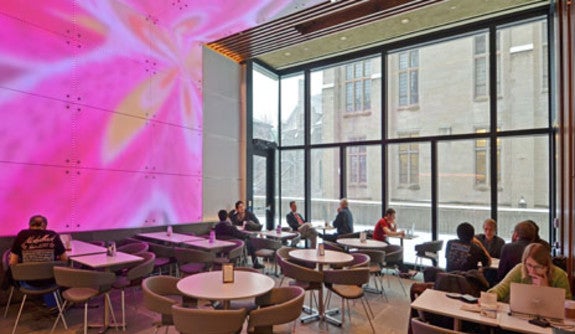LED Café — where art and science meet

Yale’s vast art collection includes celebrated works by van Gogh, Cezanne, Hopper, and Rothko. But the flashiest new canvas on campus hangs on a wall — and ceiling — in the School of Engineering & Applied Science (SEAS).
Nearly 450-square-feet in area and composed of 24,000 light emitting diodes (LEDs), the dynamic digital display runs up the east wall of the new café at Becton Center and wraps onto the ceiling. Each diode can be separately programmed, and the digital canvas, nicknamed LuxED, can display anything that lends itself to visualization. Similar technology now lights the exterior of the Empire State Building’s upper floors and mast.
Like the adjacent new Center for Engineering Innovation and Design (CEID), the artsy café and its high-tech canvas are intended to draw together engineers, scientists, artists, and humanists from around campus, and enable the casual mingling that can lead to creative collaborations.
“Engineering is the bridge between the sciences and the humanities,” said SEAS Dean Kyle Vanderlick, who proposed the café as part of renovations to Becton’s first floor. “This installation is a symbol of that.”
Already the café, Ground, which opened in January, has proven a draw for a variety of Yalies — scientists and sculptors, art critics and engineers, thespians and computer scientists. And the scientists haven’t been shy about showing their artistic side. Psychedelic depictions of turbulence flows, swirling discs of condensed matter, infinite patterns from biological physics research have all taken a turn as centerpiece art. On Valentine’s Day there was a giant, anatomically correct heart.
There’s much more in the works. Elise Morrison, a postdoctoral associate in the Department of Theater Studies, is using the space and screen for teaching a class called “Digital Media in Performance.” Johannes DeYoung, a critic in the School of Art who teaches digital video and animation, is exploring the “sculptural presentation” of video. Undergraduate Ellen Su ‘13, an art major with an interest in engineering, anticipates experiments in animation.
“Entering the space is a truly sensorial experience,” said DeYoung. “Viewers are almost completely encompassed by light.”
The light comes from the thousands of tiny LEDs. A light emitting diode is basically a simple semiconductor that allows for the direct conversion of electrical energy into light. A LED can be programmed to emit a specific color and shade of visible light. It gives off minimal heat. Each of the thousands of LEDs can be independently programmed — offering infinite possibilities for expressing light and image.
SEAS opened a café in Becton as part of Vanderlick’s continuing effort to foster a culture of engineering throughout Yale. Installing a café in Becton Center, located between the central campus and Science Hill, was one way of encouraging students and faculty of different disciplines to mingle.
“We wanted to provide a space for the broader community to gather, to chat informally, to have a sense of a ‘home,’” she said.
Bentel & Bentel, the architecture firm hired to design the space, suggested that SEAS incorporate the LED canvas — an idea that was eagerly received, both for its potential to attract non-engineers and because a digital canvas would be a physical manifestation of the intersection of science and art. The canvas is partly visible to passersby on Prospect Street.
“We saw the wall as a natural extension of the adjoining Center for Engineering Innovation and Design,” said SEAS Deupty Dean Vince Wilczynski, who discussed the LED project during its design with Leo Villareal, a Yale alumnus (B.A. 1990) and one of the world’s foremost LED artists.
New York-based Bentel & Bentel is well known for its work on fashionable restaurants — including New York City’s Gramercy Tavern, Le Bernardin, and the Modern, the restaurant at the Museum of Modern Art. For the café project, Bentel worked with Charney Architects of New Haven, which has long experience at Yale, including work on an addition to Woodbridge Hall. Philips Color Kinetics of Massachusetts — the company that provided the Empire State Building with its latest LED technology — supplied and helped integrate all the café’s LED hardware, including all 24,000 lights and the related control and interface systems.
Already, a diverse group of students and faculty has formed to share ideas and learn the subtleties of the LED hardware and software. The group has met for a digital animation class, and other classes are planned. (Members of the Yale community interested in accessing the canvas at the café should contact Isabella Quagliato at SEAS.)
And everybody can eat while they work. The café, which seats 44 people, offers coffee drinks, of course, as well as pastries, sandwiches, fruit, and other snacks. Food service by Yale Dining is available mornings and afternoons.
The café space itself is open from 8 a.m. to 11 p.m.
“Prospect Street is going to change, because of the light, the energy, the activity,” Wilczynski said. “Engineering will make its way out into the street. And engineering makes it all work.”
Media Contact
Eric Gershon: eric.gershon@yale.edu,